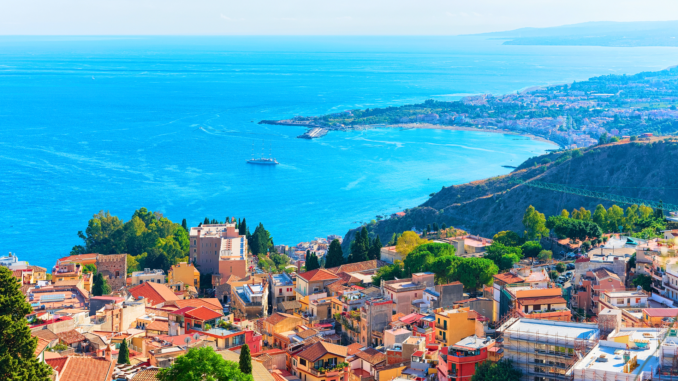
Definition
Mediterranean climate is a type of temperate climate (that is not too hot and not too cold). They have a warm temperate climate with winter rainfall. Generally, this climate is found in the countries around the Mediterranean (1).
Characteristics
-
Temperature-related characteristics
- Summers are mostly dry and hot in this climate.
- The average temperature of the warmest month in this climate zone is 21°C to 27°C.
- Daytime temperature ranges from 32 to 35°C during summer due to cloudless skies.
- Temperatures drop a lot at night.
- The climate of this region is mild in winter.
- The coldest month has a temperature of 5°C to 10°C.
- Night temperatures do not drop significantly during winter due to cloud cover.
- In this climate, the annual mean temperature range, i.e., the difference between winter and summer temperatures, is 11°C to 17°C. And the temperature difference between day and night during summer is 20° to 28°C.
- As the distance from the coast to the interior of the continent increases, the spread of warming is greater (2).
-
Precipitation-related characteristics
- The Mediterranean climate region has dry summers and wet winters.
- In winter, the coastal areas of the Mediterranean Sea are affected by the westerly winds.
- And under the influence of cold air coming from the Polar Regions, temperate cyclones are formed. Due to this, winters are humid.
- During summer, high pressure prevails in the region, causing the air to descend and warm up. As a result, the climate is hot and dry. So summer is dry without rain.
- This climate zone has an average rainfall of 40 cm to 100 cm on the western edge of the continents. However, higher elevations in the direction of the westerly winds result in slightly higher rainfall, around 130 cm.
- Snow does not fall everywhere in this climate. In winter, there is very little snow towards the poleward ends and a little more in the highlands (4).
-
Air pressure and air flow-related characteristics
- A subtropical high-pressure zone is located in the Mediterranean climate region.
- Here, pressure zones and air masses move northward with the sun’s northward movement and southward with southward movement.
- In the Mediterranean region, the north-east trade wind in summer and the westerly wind in winter in the northern hemisphere, and the trade wind in summer and the north-west westerly wind in winter in the southern hemisphere.
- Many different types of local winds blow in these climate zones. Warm and dry winds such as khamsin, sirocco, Ghibli, levanter etc., flow through this region during summer, and dry and cool winds like mistral, bora, etc., flow through this region (1) & (3).
Geographical distribution
- This climate is located between 30° and 40° latitude in both hemispheres.
- The Mediterranean climate is seen in countries like Portugal, Spain, France, Italy, on the continent of Europe in the northern hemisphere; Turkey, Syria, Lebanon in Asia; Egypt, Algeria in Africa, Cape Town in South Africa, Adelaide and Perth in Australia, Chile and Peru in South America.
- The presence of this climate can be observed mainly in the western part of the continents (1).
Special characteristics of flora and fauna
Characteristics of flora with an example
- Mediterranean climates have forests of long-leaved evergreen and occasional deciduous trees.
- Mostly softwood forests are found here.
- Plants in this region adopt different mechanisms to withstand summer dryness, similar to desert plants. For example, trees such as cork and oak have thick stems and leaves covered with a waxy coating to prevent water from escaping as vapor.
- Some plants absorb water by inserting roots deep into the soil, such as grapes.
- There are some common plants in the Mediterranean climate. They are well adapted to long periods of drought and heat. These are the toyon, chamise, poison oak, protea plants, etc.
- Plants in this climate zone can also survive in the harsh conditions. For example, eucalyptus trees, yucca trees, and olive trees.
- The olive trees are common Mediterranean plants, found in this climate zone. Mild winters and dry summers of the Mediterranean help the olive tree produce its fruit.
- Plants with hard leaves, such as scrub oaks, chamise shrubs, can survive in this climate because of the long summer (4).
Characteristics of fauna with an example
- There are about 100 types of birds found in this climate zone.
- The main characteristics of this climate are hot temperatures and very little water. All the animals in this zone have also learned how to adapt to the sometimes extreme temperatures.
- Because of the warm temperatures, it is very difficult to hunt during the day, so these animals are seen active at night.
- Acorn woodpeckers, jackrabbits, mule deer, coyotes, alligator lizards, horned toads, ladybugs, honeybees, cattle, mouflon, horses, lynx, wild boar, eagles, etc., are found in this zone.
- Many animals in this climate zone can survive without water for long periods.
- Some animals are also capable of storing water.
- In order to adapt themselves to such an environment, all these animals can observe some adaptive features such as long extremities for heat exchange, fur-covered feet, concentrated urine, oily coats, burrowing,g etc. (4).
Q&A
1. What are the 5 characteristics of a Mediterranean climate?
The 5 characteristics of Mediterranean climates are
- The Mediterranean climate has summer temperatures between 21°C and 27°C and an intertemperature between 4°C and 10°C.
- Here, winter and summer temperatures range from about 11°C to 17°C.
- One of the main characteristics of this climate is that it does not rain in summer, i.e., summers are dry and winters are wet.
- Rain falls mainly from the westerly winds in winter.
- Some Local winds blow in this climate zone, such as Mistral, Bora, Khamsin, etc.
2. What are 3 countries with a Mediterranean climate?
Spain in Europe, Morocco in Africa, and California in the United States are the three countries with a Mediterranean climate.
3. Why is it called a Mediterranean climate?
Generally, this type of climate is found in the countries around the Mediterranean Sea, so they are called Mediterranean climates.
4. Why Mediterranean climate the best?
The climate of the Mediterranean climate zones is equal to the oceanic location. That is, there is no excess of cold or warmth. So this climate zone provides a lot of opportunities, such as outdoor life, hiking, etc. That is why the Mediterranean climate is the best.
Summary
- One of the primary features of the Mediterranean climate is that the rains in winter and summer are dry.
- Generally, this region occurs in the western part of the continents between 30° and 40° latitude in both hemispheres.
- The Mediterranean climate covers only 1.7% of the Earth’s total land area.
- Average annual rainfall in this climate zone is 35 to 75 cm.
- Mediterranean climate is called the basket of fruit. A large number of different fruits are cultivated here in a commercial way. For example, olives, grapes, oranges, pears, etc. The olive is the main tree of the Mediterranean climate.
- The distribution and nature of rainfall are determined by cyclones.
- Forests of evergreen trees such as oak, cedar, pine, cork, etc., are found in the hilly areas belonging to this climate zone.
- Apart from this, there are shrubs which are known by different names in different places, such as chaparral in California.
- The Mediterranean climate region is known as the climate of perpetual fun, as the skies are clear most of the year.
- Precipitation occurs in winter, which lasts for 3 to 4 months.
- The remaining 8 months of the Mediterranean climate region are cloudless, clear, and sunny, as there is little precipitation due to the trade winds.
- The average night temperature does not drop much as the cloud cover is high in winter in this climate zone. Frost may occur at some places, especially in lowland areas during winter (2) & (4).
ReferenceS
- Savindra Singh. Climatology. Pravalika Publications, Allahabad. Chapter 14: Climatic types and biomes. Page No: 316 to 319.
- https://ncert.nic.in/ncerts/l/kegy212.pdf
- https://books.google.co.in/books?id=9JvtBQAAQBAJ&newbks=0&printsec=frontcover&pg=PA278&dq=marine+west+coast+climate&hl=en&redir_esc=y#v=onepage&q=mediterranean%20climate&f=false
- https://meteor.geol.iastate.edu/~kuballc/portfolio/406%20Version%202.pdf
